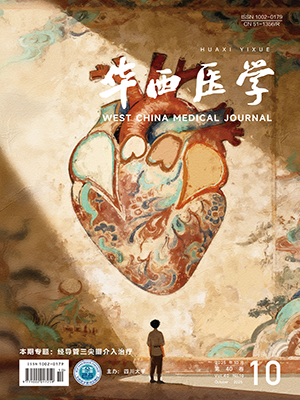| 1. |
Zhang L, Wang F, Wang L, et al. Prevalence of chronic kidney disease in China:a cross-sectional survey[J]. Lancet, 2012, 379(9818):815-822.
|
| 2. |
Kang SH, Cho KH, Park JW, et al. Risk factors for mortality in stable peritoneal dialysis patients[J]. Ren Fail, 2012, 34(2):149-154.
|
| 3. |
Tam P. Peritoneal dialysis and preservation of residual renal function[J]. Perit Dial Int, 2009, 29(Suppl 2):S108-S110.
|
| 4. |
王丽妍, 张东亮, 刁宗礼, 等. 透析患者残余肾功能的保护[J]. 中国血液净化, 2012, 11(2):95-98.
|
| 5. |
Abbate M, Zoja C, Remuzzi G. How does proteinuria cause progressive renal damage?[J]. J Am Soc Nephrol, 2006, 17(11):2974-2984.
|
| 6. |
Singhal MK, Bhaskaran S, Vidgen E, et al. Rate of decline of residual renal function in patients on continuous peritoneal dialysis and factors affecting it[J]. Perit Dial Int, 2001, 20(4):429-438.
|
| 7. |
陈香美. 中国腹膜透析技术发展现状与未来[J]. 中国实用内科杂志, 2013, 33(6):413-415.
|
| 8. |
龚蓉, 陈泽君, 皮婧婧, 等. 三级医院与社区医院联合管理居家腹膜透析患者实践效果的初讨[J]. 华西医学, 2014, 29(5):831-834.
|
| 9. |
Paniagua R, Amato D, Voneshi E, et al. Effects of increased peritoneal clearances on mortality rates in peritoneal dialysis:ADEMEX, a prospective, randomized, controlled trial[J]. J Am Soc Nephrol, 2002, 13(5):1307-1320.
|
| 10. |
Bargman JM, Thorpe KE, Churchill DN, et al. Relative contribution of residual renal function and peritoneal clearance to adequacy of dialysis:a reanalysis of the CANUSA study[J]. J Am Soc Nephrol, 2001, 12(10):2158-2162.
|
| 11. |
Moist LM, Port FK, Orzol SM, et al. Predictors of loss of residual renal function among new dialysis patients[J]. J Am Soc Nephrol, 2000, 11(3):556-564.
|
| 12. |
Liao CT, Shiao CC, Huang JW, et al. Predictors of faster decline of residual renal function in Taiwanese peritoneal dialysis patients[J]. Perit Dial Int, 2008, 28(Suppl 3):S191-S195.
|
| 13. |
Liu JH, Wang SM, Chen CC, et al. Relation of ankle-brachial index to the rate of decline of residual renal function in peritoneal dialysis patients[J]. Nephrology (Carlton), 2011, 16(2):187-193.
|
| 14. |
Kolesnyk I, Noordzij M, Dekker FW, et al. Treatment with angiotensinⅡ inhibitors and residual renal function in peritoneal dialysis patients[J]. Perit Dial Int, 2011, 31(1):53-59.
|
| 15. |
Reyes-Marín F, Calzada C, Ballesteros A, et al. Comparative study of enalapril vs. losartan on residual renal function preservation in automated peritoneal dialysis. A randomized controlled study[J]. Rev Invest Clin, 2012, 64(4):315-321.
|
| 16. |
Akbari A, Knoll G, Ferguson D, et al. Angiotensin-converting enzyme inhibitors and angiotensin receptor blockers in peritoneal dialysis:systematic review and meta-analysis of randomized controlled trials[J]. Perit Dial Int, 2009, 29(5):554-561.
|
| 17. |
Ryckelynck JP, Goffin É, Verger C, et al. Maintaining residual renal function in patients on dialysis[J]. Nephrol Ther, 2013, 9(6):403-407.
|




